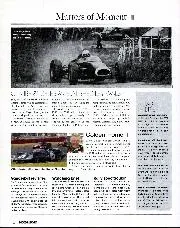
Watching brief
A new website allows enthusiasts to select from 550 short motoring and racing films, which are then put on DVD and sent by mail. Footage dates from the 1904 Vanderbilt…
At the time of writing we’ve just had the first race of F1’s new era, the first time the cars legislated to be able to race wheel-to-wheel actually raced. The proof of concept race. All those years, all that investment, all those clever minds and computation, all those meetings, all the closing of possible loopholes: as the gantry lights went out in Bahrain, how was this going to pan out?
“You can follow more closely,” observed Max Verstappen in pre-race testing. “At least you don’t have this weird loss of downforce where suddenly you have a lot of understeer or massive oversteer.”
Charles Leclerc agreed. “It is quite interesting. Because I’ll say from three seconds to one second behind the car in front, you actually can follow closer than before. “Then from one second to five-tenths I will say it’s similar to the feeling I had last year and then from five-tenths to extremely close, then this is much better than last year. It is nice, it’s interesting. I mean, I’ll have to do a few more laps behind a car, but it’s looking good for now.”
There was a briefly thrilling three-lap dice for the lead between those two drivers (see our race report on page 26), but their passing and re-passing owed more to DRS than the ability to follow closely. It seems the cars can follow more closely but not many drivers were choosing to do it. Why so? The limiting factor in Bahrain was temperatures – of the brakes and, to a lesser extent, the tyres.
“Bahrain was perhaps too extreme a test for the new regulations”
“Following was definitely easier,” assessed Fernando Alonso. “We spotted already in test that it was already easier to follow cars. But all the overtakes we saw today was because one car had two seconds more pace, newer tyres than others. I met cars that I was two seconds faster than and I overtake in a few corners, and I met also cars that were two seconds faster than me and they overtook me in two or three corners. The tyre is the biggest differentiating factor still, not the following. We need to see more examples. I know that it’s tempting to write conclusions after one race, but we need to be calm and judge after more races.”
The tyres were still thermally degrading – as they always do at Sakhir. The combination of layout and surface makes this circuit an extremely tough test. So we had the very familiar scenario of cars being driven at around 2.5sec off their potential pace (7sec slower than qualifying, 3.9sec of which would be fuel weight, around 0.3sec depleting the full battery store in one qualifying lap, around 0.8sec the difference between a brand new tyre and a used one). Driving a car like this, the degradation rate of the soft tyre was still a very high 0.12sec per lap.
Driving at 2.5sec off the possible pace is what was required to get the necessary stint lengths for a two-stop strategy in Bahrain. Push harder than that and the tyre would overheat and within a couple of laps the time loss would balloon massively. This has been the default style of F1 race for some years to a greater or lesser extent. Sometimes on a cool day and with the right tyre compound they can be driven close to flat-out, but such days are rare. The new Pirellis have been designed to be less thermally sensitive and – crucially – so that if they do get too hot, the theory is that backing off will bring them back to life. Which was not the case before.
It seems that the new tyres do have a better recovery from being over-temperature. But the thermal mechanism of degradation is still very much there and if your tyres are going to become radically slower if you get them too hot, there’s not much advantage to be gained from having aero which allows you to follow closely when doing so still overheats the tyres.
Similarly, if your brake discs are going to oxidise to nothing if you run them too hot for too long, it really doesn’t matter much if the aero allows you to follow closely if doing so destroys your brakes. Max Verstappen had overheated his by lap three of the race and spent most of the rest of the first stint bringing his temperatures back under control by lifting and coasting. When he did attack Leclerc after the first stops, he was able to do out-braking moves on two consecutive laps into Turn 1 but an attempt at a third left him having to nurse the brakes once more.
So Bahrain was perhaps too extreme a test for the new regulations because the ease of following was always going to be a second-or third-order factor in what passing and re-passing there was. Furthermore, it’s always been a track, even under the old regulations, where passing wasn’t too difficult.
So as Fernando says, there was plenty of overtaking but it was to do with different tyre ages on a track where there is a bigger than usual lap time difference between new and old thermally degraded tyres. But among cars actually racing each other for position there was no more passing than before, regardless of whether the aero makes it easier to follow!
All of which simply defers the question of whether the regulation revisions have achieved what they set out to do until we get to another track. There are some positives, but the particular challenges of Bahrain muddied the waters somewhat.
Since he began covering grand prix racing in 2000, Mark Hughes has forged a reputation as the finest Formula 1 analyst of his generation
Follow Mark on Twitter @SportmphMark